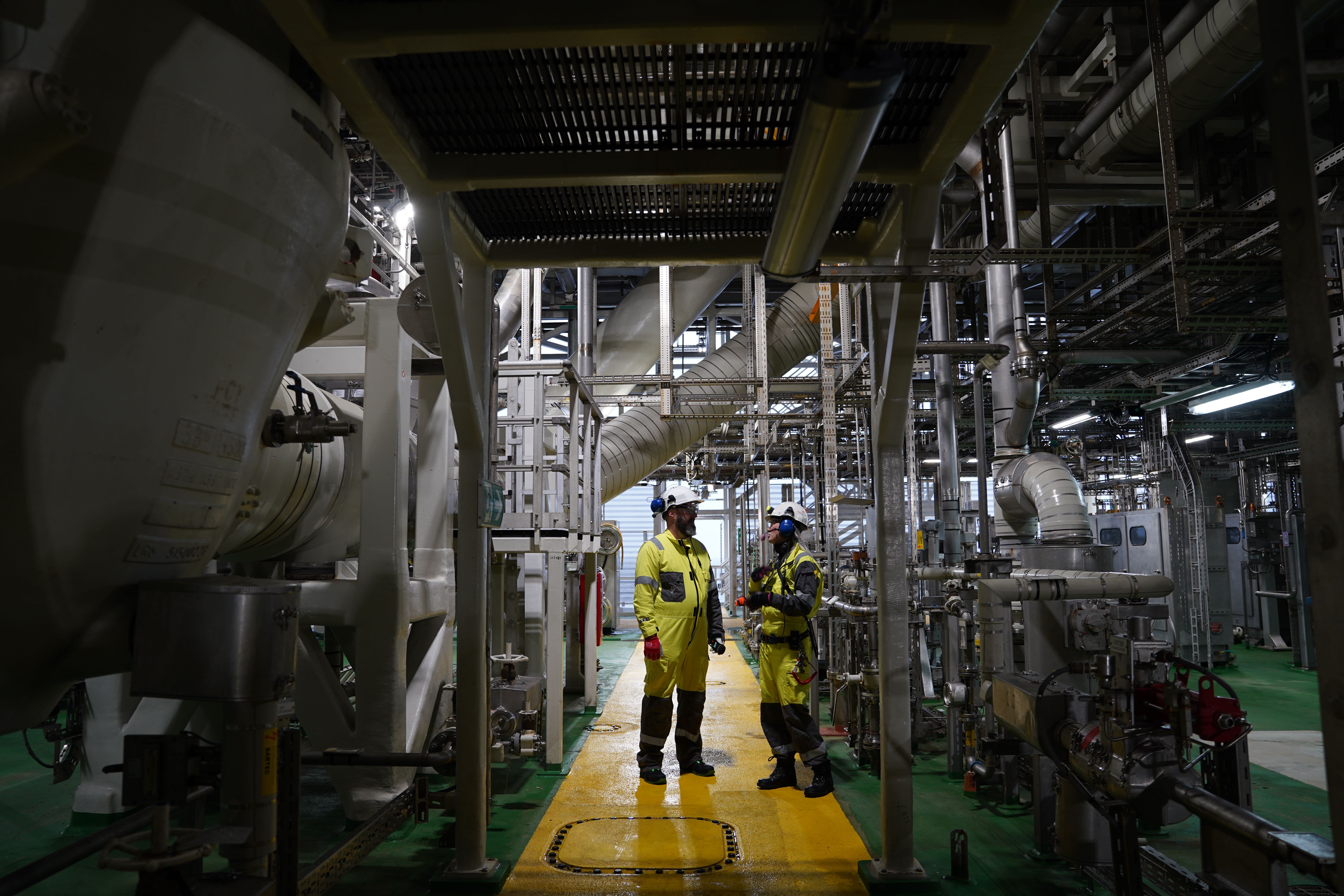An Equinor employee talks to a reporter on a rig used to produce oil from the Johan Sverdrup oil field some 140 kilometres west from the town of Stavanger, Norway, on December 3, 2019.
TOM LITTLE | AFP via Getty Images
LONDON — A strike by workers in the Norwegian oil sector could soon wipe out nearly one-quarter of the country’s petroleum output, Norway’s Oil and Gas Association warned on Thursday, with the intensifying dispute helping oil prices to build on recent gains.
International benchmark Brent crude futures traded at $43.09 a barrel on Thursday afternoon, up more than 2.6%, while U.S. West Texas Intermediate futures stood at $41.01 a barrel, around 2.7% higher.
The dispute between Lederne union and the Norwegian Oil and Gas Association began when talks collapsed on Sept. 30, prompting production outages from Oct. 5.
Lederne is pushing for the organization to match the pay and conditions at onshore remote-control rooms with those of offshore workers. The striking union told CNBC that this request would not impose an additional cost on companies.
“Lederne fear that this is the start of a deterioration of our members’ accumulated pay and working conditions, and therefore see no other option than to use the right to strike when negotiations and mediation do not succeed,” the union said via email.
At present, 169 Lederne members are on strike on four platforms: Johan Sverdrup, Gudrun, and Gina Krog (all operated by Norway’s state-controlled energy giant Equinor), and Gjoa (operated by Neptune Energy).
From midnight on Oct. 10, Lederne said an additional 93 members on the following platforms would also go on strike: Kristin, Oseberg Sor, Oseberg Ost (all operated by Equinor), and the Ekofisk Bravo/Kilo installation (run by U.S. producer ConocoPhillips).
An oil drilling platform sits on board the world’s largest construction vessel, the Pioneering Spirit, in the Bomla fjord near Leirvik, ahead of its transportation to the Johan Sverdrup oil field, Norway, on Friday, June 1, 2018.
Carina Johansen | Bloomberg | Getty Images
“The demands from Lederne suggest that we either expand the scope of the shelf agreement or establish a new agreement for the members they have onshore,” a spokesperson for Norway’s Oil and Gas Association told CNBC via email.
“Both alternatives are far beyond the regulatory provisions of the collective agreement. Norwegian Oil and Gas cannot accept either an extension or a new agreement,” they added.
The association said the financial offer it had made had been accepted by the two largest unions, Industri Energi and Safe, which together represent 85% of the employees covered by the shelf agreements.
Nonetheless, it said, “the demands from Lederne were otherwise significantly higher than what was agreed in the lead sector settlement.”
Six offshore oil and gas fields shut down on Monday as a result of the strike action, Norway’s Oil and Gas Association said, cutting output by 8% or 330,000 barrels of oil equivalent per day.
Western Europe’s largest oilfield at risk
“Strike is a lawful action,” Norway’s Ministry of Labor and Social Affairs told CNBC on Thursday in an emailed statement.
“The responsibility for reaching a solution in this situation lies first and foremost with the social partners,” the Ministry said, adding it would “monitor the situation in the same fashion as with any other labor conflict.”
In 2012, Norway’s government used emergency powers to step in and force offshore oil and gas workers back to work, bringing an end to a 16-day strike.
Equinor on Wednesday warned that “if the ongoing strike on the Norwegian continental shelf continues until 14 October, the Johan Sverdrup field in the North Sea will have to close production until further notice.”
It said Lederne had taken out 43 members at Johan Sverdrup, Western Europe’s largest oilfield, but production had not yet been affected.
That would change if the strike continued through to Oct. 14, Equinor said. “This is due to the scheduled rotation of personnel as there would not be sufficient capacity and competence in key operational functions at Johan Sverdrup.”
‘Financial pressure’
“Oil companies are under financial pressure, having to keep a very tight control of costs and there’s an understandable push back from the workforce against that, resulting in the strikes that we are seeing,” Spencer Welch, director of oil, markets and downstream energy at IHS Markit, told CNBC’s “Squawk Box Europe” on Wednesday.
“In terms of the global oil market, what is happening in Norway is pretty irrelevant in terms of market influence,” Welch said, estimating the northern European country was accountable for 0.3% of global demand.
“At the moment, there is way too much oil compared with the world’s demand and, until coronavirus goes away, that situation won’t change,” he added.
